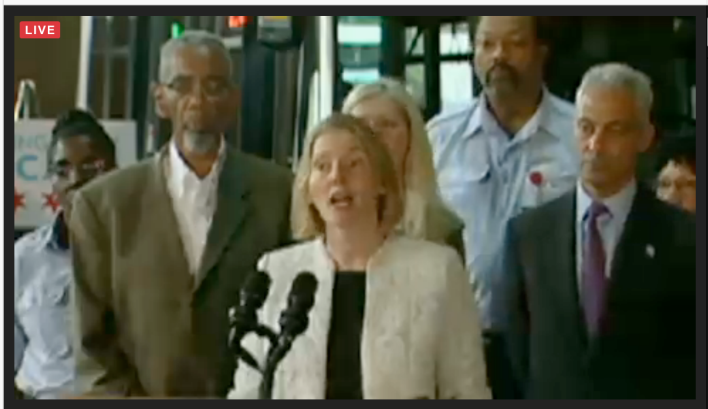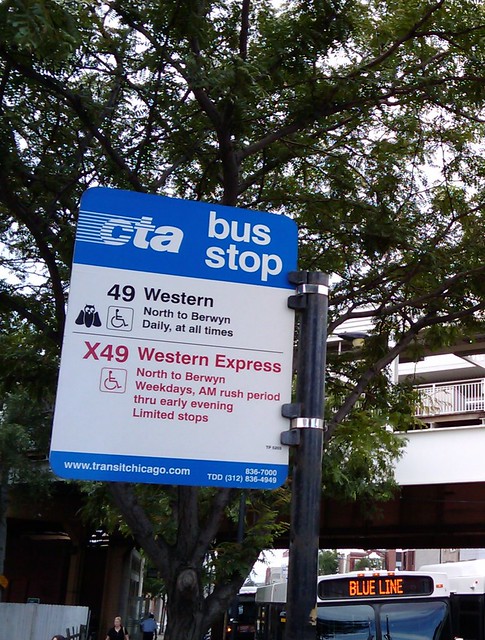This morning Mayor Rahm Emanuel and CTA President Dorval Carter announced the return of the #X9 Ashland Express and #X49 Western Express buses. These limited-stop, morning through evening routes formerly paralleled the #9 Ashland and #49 Western local bus lines. While the stops for the local routes are generally spaced a mere one-eighth of a mile apart, the express buses only stopped every half-mile or so, for a roughly 75-percent reduction in stops.
The old #X9 and #X49 routes had good ridership because they offered modest savings in travel times compared to the locals. For example, the CTA estimates that the Ashland express bus traveled an average of 10.3 mph during rush hour, including stops, compared to the 8.7 mph local buses. However, the Ashland and Western express bus routes were eliminated due to funding shortfalls back in 2010, along with nearly every other Chicago express route, save for the Lake Shore Drive lines.
The city plans to make the new #X9 and #X49, as well as the locals, run somewhat faster than before by adding a bus rapid transit-style feature on Western and Ashland. Transit-signal priority will be implemented on these streets, so that stoplights will turn green earlier or change to red later to keep all buses from being delayed. Fewer stops plus TSP means express bus riders will save up to 22 minutes on trips along each route, compared to the current local service, according to the CTA.
The #9 Ashland is currently the CTA's highest-ridership bus line, while the #49 Western has the third-highest ridership, after the #79 bus on 79th Street. The agency predicts that the new express service will lead to a four-percent increase in ridership on the Ashland route, according to its application for a federal Congestion Mitigation and Air Quality Improvement grant, which will help bankroll the TSP features.
Of course, an express bus ride that's, say, seven minutes shorter than traveling the same stretch on a local bus doesn't save you any time if you wait ten minutes longer to catch the express. Hopefully, the #X9 and #X49 will have short headways to maximize the time savings for customers. Otherwise, it might make more sense for riders to simply board the first bus that shows up, rather than wait longer for an express.
Meanwhile, the CTA also plans to speed up the local bus service on these streets by eliminating some of the least-used stops, a strategy that the agency says could save #9 and #49 riders up to 12 minutes per trip. The CTA will undertake a community input process this fall to solicit feedback about the stop consolidation plan.

This announcement begs the question, why is the city moving forward with express bus service on these streets, when its proposal for full-blown BRT on Ashland seems to have stalled? In addition to limited stops and TSP, that project would include dedicated bus lanes for center-running buses, pre-paid, level boarding, and other time-saving features that the CTA predicts would nearly double current bus speeds. According to a source, the agency considers the reintroduction of the express routes to be a step towards implementing Ashland BRT.
In a statement this morning, Active Transportation Alliance executive director Ron Burke said the current express bus project "should be a first step towards CTA building a true bus rapid transit corridor on Ashland." He noted that, even though the new express service will be faster than the current snail's pace of the locals, "buses will still be stuck in traffic during peak periods...and trips will remain unpredictable" due to the lack of dedicated lanes.
At a press conference this morning at the CTA's 74th Street bus garage, Mayor Emanuel insisted that the new express service is a separate project from the Ashland BRT. "The only BRT I'm investing in right now is the [Loop Link] in the Central Business District," he said. "We need to make these investments [on Ashland and Western] irregardless."
The #X9 and #x49 buses will be back on the streets this fall. TSP should be implemented by spring 2016 on Ashland from Cermak Road to 95th Street by spring 2016, on Western from Howard Street to 79th Street by the end of the year, and on Ashland from Cermak to Irving Park Road by the end of 2017.
The cost of setting up TSP on both streets is $27 million, which is funded by $17 million from the Regional Transit Authority, plus a $10 million CMAQ grant, according to CTA spokeswoman Tammy Chase. The $3-3.5 million per year required to operate the express buses will come from the CTA's general operating fund, Chase said.




